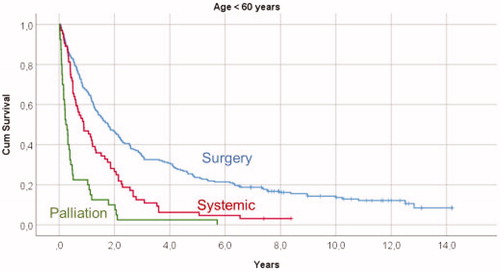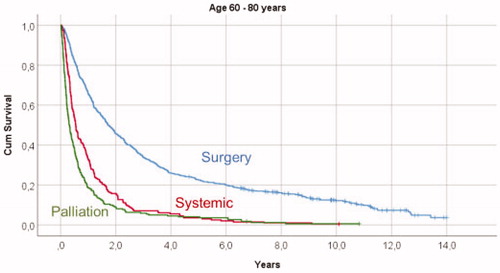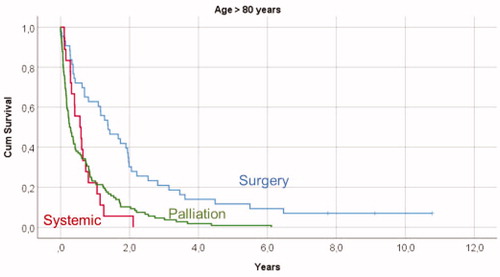Figures & data
Table 1. Patients age, tumor size, gender, and distribution of T-stage, N-stage, Fuhrman grade and RCC type are shown in relation to given primary treatment in 1483 patients with metastatic renal cell carcinoma at diagnosis. Percentages of gender distribution in brackets.
Table 2. Distribution of T-stages in relation to gender in 1483 patients with metastatic renal cell carcinoma.
Figure 1. Kaplan-Meyer survival curves illustrating overall survival in relation to primary treatment in mRCC patients younger than 60 years, showing significant survival differences between all given treatments (p < .001).

Figure 2. Kaplan-Meyer survival curves illustrating overall survival in relation to primary treatment in mRCC patients 60–80 years old, showing significant survival differences (p < .001) when comparing surgical treatment with both systemic therapy and palliation, and a significant survival difference (p = .001) between systemic therapy and palliation.

Figure 3. Kaplan-Meyer survival curves illustrating overall survival in relation to primary treatment in mRCC patients older than 80 years, showing significant survival differences between the given treatments (p < .001) when comparing surgical treatment with both systemic therapy and palliative treatments, but no difference in overall survival (p = .981) between patients treated with systemic therapy and palliation.

Table 3. Hazard ratio (HR) and 95 % confidence interval for overall survival in 1483 patients with metastatic renal cell carcinoma at primary diagnosis according to: T-stage, tumor size, N-stage, given treatment, gender, and patients age groups and years of diagnosis, using a multivariate Cox regression analysis.
Table 4. Mean and median overall survival times, in years, with 95% confidence intervals, are shown in relation to the given primary therapy in 1483 patients with metastatic renal cell carcinoma.
